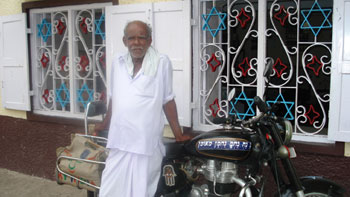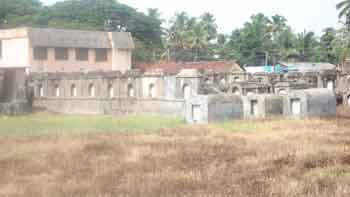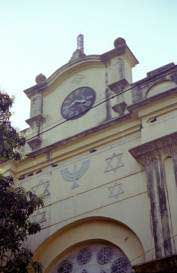India Virtual Jewish History Tour
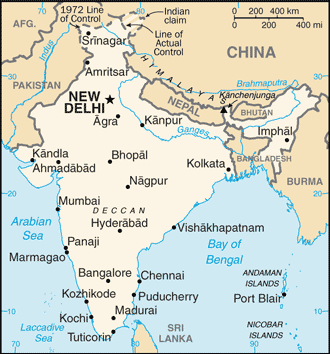 |
The Republic of India, located in South Asia, is the second most populous nation in the world, with over 1.2 billion people. The country has a rich historical legacy of three distinct ancient Jewish groups. Today, the Jewish population of India is approximately 4,500.
Learn More - Cities of India:
Ahmadnagar | Alibag | Benares | Mumbai | Calcutta | Calicut | Ceylon | Chennamangalam | Cranganore | Ernakulam | Goa | Poona
Early History
Bene Israel Jews
The Jews of Cochin
The Jews of Calcutta
Baghdadi Jews
Bene Menashe
Bene Ephraim
Chabad
Relations with Israel
Early History
India has a legacy of three distinct ancient Jewish groups: the Bene Israel, the Cochin Jews (also called the Malabar Jews), and the White Jews from Europe. Each group practiced essential elements of Judaism and had active synagogues. The Sephardic rites predominate among Indian Jews. More recent Jewish immigration to India includes the Baghdadi Jews, Bene Menashe, and Bene Ephraim.
Jewish merchants from Europe traveled to India in the medieval period for trade, but it is unclear whether they established permanent settlements in South Asia. Our earliest reliable evidence of Jews living in India dates to the early 11th century. The first Jewish settlements were certainly centered along the western coast. Abraham ibn Daud’s 12th-century reference to Jews of India is unfortunately vague, and we do not have further references to Indian Jews until several centuries later.
Migrations in the 16th and 17th centuries created significant settlements of Jews from Persia, Afghanistan, and Characin (Central Asia) in northern India and Kashmir. By the late 18th century, Bombay became the largest Jewish community in India. Bene Israel Jews lived in Bombay, as did Iraqi and Persian Jews.
Bene Israel Jews
The Bene Israel (“Sons of Israel”) lived primarily in Bombay (now Mumbai), Pune, Karachi (now in Pakistan), and Ahmadabad. Their native language was Judeo-Marathi. They arrived in India nearly 2,100 years ago after a shipwreck stranded seven Jewish families from Judea at Navagaon near Alibag, just south of Mumbai.
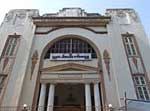 Bene Israel Synagogue |
|---|
The Bene Israel claim to be descended from Jews who escaped persecution in the Galilee in the 2nd century B.C.E. The Bene Israel resembled the non-Jewish Marathas in appearance and customs, suggesting intermarriage between Jews and Indians. The Bene Israel, however, maintained the practices of Jewish dietary laws, circumcision, and observation of the Sabbath as a day of rest.
The Bene Israel say their ancestors were oil pressers in Galilee and earned the nickname “Saturday oil-pressers” because they abstained from work on Saturday, which is the Jewish Shabbat, a day of rest. In the 18th century, they were “discovered” by traders from Baghdad. At that time, the Bene Israel practiced only a few outward forms of Judaism (which was how they were recognized), but had no scholars of their own. Teachers from Baghdad and Cochin taught them mainstream Judaism in the 18th and 19th centuries.
In 1796, “Shaar Rahamim,” the first Bene Israel synagogue, was built in the city. After its establishment, several other synagogues and Jewish centers emerged throughout Bombay.
David Sassoon and his followers fled to Bombay in 1832 following the pogroms carried out by Daud Pasha in Baghdad. The Sassoon family became known as the “Rothschilds of the East” for their wealth from trade and philanthropic donations to the community. In fact, many of Mumbai’s well-known landmarks today can be attributed to the Sassoon family.
In the 1830s, an estimated 6,000 Bene Israeli Jews lived in India, and nearly 10,000 at the turn of the century. At their peak in 1948, the Bene Israel numbered 20,000. Since then, most have migrated to Israel, and under 5,000 remain today.
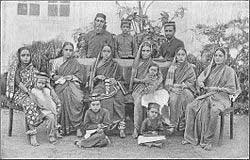 Bene Israel |
|---|
In 1964, the Rabbinate of Israel declared that the Bene Israel are "full Jews in every respect."
The Bene Israel community claimed to be descendents of the Kohanim, the ancient Israelite priests. They also claim descent from Aaron, Moses’ brother. In 2002, a DNA test confirmed that the Bene Israel share the same heredity as the Kohanim.
The Jews of Cochin
The first Jews to come to India were the Jews of Cochin in southern India (today, it's the port city of Kochi), the so-called “Black Jews,” who traditionally spoke Judeo-Malayalam, a language native to the state of Kerala. Some say that these “Black Jews” settled on the Malabar coast during the time of King Solomon of Israel, and after the Kingdom of Israel split into two. The Pardesi Jews, also called the “White Jews,” settled later, coming to India from Western European nations such as Holland and Spain, and spoke the ancient Sephardic language of Ladino. A notable center of Spanish and Portuguese Jews, established in the 15th century, was Goa, but it eventually disappeared. In the 17th and 18th centuries, Cochin had an influx of Jewish settlers from the Middle East, North Africa, and Spain.
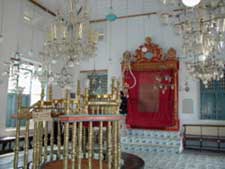 Pardesi Synagogue Cochin |
|---|
The Jews of Cochin traditionally say that they came to Cranganore (an ancient port near Cochin in south-west India) after the destruction of the Temple in 70 C.E. They had, in effect, their own principality for many centuries until a chieftainship dispute broke out between two brothers in the 15th century. The disagreement led neighboring princes to dispossess them. In 1524, the Moors, backed by the ruler of Calicut (today called Kozhikode) attacked the Jews of Cranganore on the pretext that they were tampering with the pepper trade. Most Jews fled to Cochin and went under the protection of the Hindu Raja there. He granted them a site for their own town that later acquired the name "Jew Town" (by which it is still known).
Unfortunately for the Jews of Cochin, the Portuguese occupied Cochin during this same period and indulged in persecution until the Dutch displaced them in 1660. The Dutch Protestants were tolerant, and the Jews prospered. In 1795, Cochin came under British influence. In the 19th century, Cochin Jews lived in the towns of Cochin, Ernakulam, Aluva, and North Paravur.
Most of Cochin‘s Jews have emigrated (principally to Israel), intermarried, or converted, and now there are believed to be only 13 elderly Indian-born Jews from seven families still living in Kochi. There are currently 53 practicing Cochin Jews in Kerala, along with three synagogues. The Pardesi Synagogue in Kochi, built in 1568, is the only one still open and is a protected heritage site. Many fear that the Jews of Cochin will soon wither away.
On August 11, 2024, it was reported that Queenie Hallegua, the last Jewish woman of the Paradesi community in Kochi, India, passed away at 89, leaving her nephew as the final Jew in the area. Queenie played a significant role in the community, serving as the warden of the 450-year-old Paradesi Synagogue and managing partner of the historic S. Koder House. Her passing marks a significant moment for the Jewish community in Kochi, which once had thousands of members but has dwindled over the years. The Paradesi community is remembered for its cultural contributions and dedication to tradition.
|
|
|
The Jews of Calcutta
Near the end of the 18th century, a third group of Indian Jews appeared. They were the Middle Eastern Jews who came to India through trade, establishing a network that connected Aleppo, Baghdad, Basra, Surat, Bombay, Calcutta, Rangoon, Singapore, Hong Kong, and eventually Kobe, Japan. Strong family bonds linked traders across these cities.
|
|
Shalom Aharon Ovadiah HaCohen, the founder of the Calcutta Jewish community, was born in Aleppo in 1762. He left in 1789, arrived in Surat in 1792, and traded as far as Zanzibar. In 1798, he moved to Calcutta, where he was joined by his nephew, Moses Simon Duek HaCohen, in 1805. Duek HaCohen married Ovadiah HaCohen’s eldest daughter, Lunah. Other traders followed, and the Baghdadi Jews soon outnumbered those from Aleppo.
Under British rule, Calcutta’s Jewish community grew in population and wealth, maintaining trade with cities across the Far East and beyond. The tolerant Indian society allowed the Jews of Calcutta to feel at home. The community’s numbers peaked at around 5,000 during World War II as refugees fled the Japanese advance into Burma.
While the early generations of Calcutta Jews spoke Judeo-Arabic at home, English became the preferred language by the 1890s. However, after WWII, the rise of Indian nationalism caused Jews to feel increasingly uneasy as they were perceived as aligned with the British. As a result, many emigrated to Israel, England, and the United States, leading to a sharp decline in India’s Jewish population. Today, the Jews of Calcutta number around 2,150, including 150 Europeans and the remainder natives of Asiatic Turkey, Persia, and southern Arabia.
The Elias Meyer Free School and Talmud Torah in Calcutta’s Bowbazar symbolize the Baghdadi Jewish community’s legacy. Established with a donation from Elias Meyer in 1920 and completed in 1925, the school was renamed in his honor after his death that same year. It provided free education to Jewish boys, focusing on Jewish values and religious learning while supporting students with meals, clothing during the High Holidays, and spiritual guidance.
Initially, Jewish boys attended Christian mission schools, but concerns over proselytization prompted community leaders to establish their own schools in the 1890s. The Jewish Girls School was founded on Park Street, while the boys’ school evolved through several iterations before becoming the Elias Meyer Free School and Talmud Torah.
During the community’s peak in the 1940s, the school was a central institution in Jewish life. However, emigration following Indian Independence, Partition, and WWII significantly reduced the Jewish population. By 1955, the school began admitting non-Jewish students who paid fees, ensuring its continued operation. The last Jewish principal, Moses Elias, served from 1955 to 1979.
Today, although only a few Jews remain in Calcutta, the school’s centenary celebrations honor its enduring legacy. Alumni, primarily non-Jewish, maintain strong ties to the institution, contributing to its preservation. A series of events will be held annually to commemorate a century of educational excellence and cultural continuity. Near the end of the 18th century, a third group of Indian Jews appeared. They were the Middle Eastern Jews who came to India through trade. They established a trading network stretching from Aleppo to Baghdad to Basra to Surat/Bombay to Calcutta to Rangoon to Singapore to Hong Kong and eventually as far as Kobe, Japan. There were strong family bonds amongst the traders in all these places.
Baghdadi Jews
The Baghdadi Jewish community, so-called because they are descendents of Iraqi Jewish immigrants who came to that country during the British Raj, not only includes Jews from the Iraqi capital city of Baghdad, but from other areas of Iraq, as well as Jews from Syrian, Yemenite, Persian, and Turkish origin. The community developed as a result of Jews fleeing religious persecution in Muslim lands to the northwest of India during the British imperial era. Unlike other Jewish communities in India, whose oral tradition attests to a presence in India going back as long as 2000 years, the Baghdadi communities were established relatively recently (in the past few centuries).
The Baghdadis have completely assimilated into Indian society. A contributing factor to their assimilation was their physical features and resemblance to the East Indians. The Baghdadis originally came to India from Iraq, Turkey, Syria, Iran, and Afghanistan, so they had dark olive skin and black, dark brown hair, which gave them a distinct Middle Eastern appearance and an Indian resemblance.
Bene Menashe
The Bene Menashe community consists of members of the Chin-Kuki-Mizo tribe, which lives in the northeast Indian states of Manipur and Mizoram, near the border of Myanmar. Linguistically, they are Tibeto-Burmans. For generations, they have kept Jewish traditions, claiming descent from the Tribe of Manasseh, one of the Ten Lost Tribes of Israel, which the Assyrians exiled in the eighth century B.C.E. and has since disappeared.
In the 19th century, the tribe‘s members were converted to Christianity, but in the 1970s, some of the community began practicing Judaism again and set themselves apart from the rest of the tribe, after Pentecostalist called Chalianthanga or Mela Chala (the name varies) from the Buallawn village dreamt that God instructed him to direct his people to return to their pre-Christian religion, which he determined to be Judaism and to return to their original homeland, Israel.
|
|
|---|
The group was named Bene Menashe by Rabbi Eliyahu Avichail, who heard of the tribe in 1979 and traveled to their village in India several times in the 1980s, believing that the legendary Kuki-Mizo ancestor Manmasi is the same as Menassah, son of Joseph. Rabbi Avichail’s organization, Amishav (Hebrew for “my people return”), dedicated itself to converting the Bene Menashe to Orthodox Judaism and, eventually, to bringing them to settle in Israel.
In July 2005, the Bene Menashe community built its first mikvah, or a Jewish ritual bath, in Mizoram under the supervision of Israeli rabbis to begin the conversion process. Shortly after, a similar mikvah was built in Manipur. In mid-2005, with the help of Shavei Israel, an organization founded by Avichail’s friend, journalist Michael Fruend, and the local council of Kiryat Arba, the Bene Menashe opened its first community center in Israel.
In March 2005, Chief Rabbi Shlomo Amar, one of Israel’s two chief rabbis, decided to recognize the members of India’s Bene Menashe community as descendants of the ancient Israelites due to their exceptional devotion to Judaism. Nevertheless, those who arrive in Israel are only granted full citizenship after a one-year temporary citizenship and conversion process.
Indian religious figures in the Mizo-Kuki churches in Mizoram, as well as Indian government officials, later expressed concern about the plan to convert the Bene Menashe and bring them to Israel, so the effort was suspended. However, members of Bene Menashe continued to arrive in Israel in 2006 and 2007. After five years with no aliyah, the Israeli government announced in November 2012 that it would resume flights to bring the Bene Menashe to Israel, starting with a planeload of 270 people.
Since the early 1990s, approximately 3,000 Bene Menashe have immigrated to Israel; another 7,000 are in the pipeline awaiting immigration. In October 2013, the Israeli government approved the arrival of 899 more Bene Menashe. Seventy-eight Bene Menashe landed in Israel in June 2015 and became the first Bene Menashe to settle in the Golan Heights. In November 2017, 162 Bnei Menashe arrived in Israel to reunite with family members and make new lives in the country. The most significant influx of Bene Menashe Jews to Israel was in 2018, with approximately 430 making aliyah in the first 6 months of the year.
In November 2025, Israel approved a plan to accelerate the immigration of the Bnei Menashe community from northeast India amid escalating ethnic unrest in Manipur and Mizoram. Under the decision proposed by Prime Minister Benjamin Netanyahu and Immigration Minister Ofir Sofer, 1,200 Bnei Menashe will immigrate by the end of 2026, with another 5,800 expected by 2030—effectively completing the aliyah of the entire community and reuniting them with the roughly 4,000 members already in Israel. New arrivals will be absorbed in Nof HaGalil and other northern cities. Netanyahu called the move “an important and Zionist decision” that will strengthen Israel’s North and the Galilee.
Bene Ephraim
The Bene Ephraim (in Hebrew, Sons of Ephraim
) are a small group of Jews, sometimes called the Telugu Jews because they speak Telugu, a Dravidian national language of India. They reside in the southeastern Indian state of Andhra Pradesh. Their recorded observance of Judaism, like that of the Bene Menashe, is relatively recent, going back only to 1981. In the 19th century, the Bene Ephraim were converted to Christianity by Baptist missionaries.
Since 1981, about 50 families in Kottareddipalem and Ongole (the capital of the nearby Prakasham district) have begun studying and teaching Torah, learning Hebrew, and seeking recognition from other Jewish communities around the world. Over the years, several groups of rabbis have visited the community, but they have thus far not seen fit to accord this community the same recognition as that recently extended to the Bene Menashe.
In 1992, the first Bene Ephraim synagogue, called The House of the Children of Yakob, opened in Kottareddipalem. It was founded by former Christian preacher Shmuel Yakobi, who first encountered Judaism in the 1980s on a trip to Jerusalem. Yakobi also founded an independent open university offering correspondence courses in Torah and Hebraic Studies, calling the community the Council of Eastern Jewry.
Chabad
The Chabad Movement in Mumbai was established in 2003, and Chabad purchased the Nariman House building in 2006. The Chabad house in Mumbai served many Israeli tourists and Jewish businessmen with lodging, kosher food, and a place of worship.
For three days between November 26 and November 28, 2008, Pakistani Muslim extremists terrorized the city of Mumbai. They killed many tourists at the Taj Mahal and Oberoi hotels, as well as the Victoria Terminus train station.
After leaving the hotels, terrorists invaded the Chabad center at the Nariman House building, killing all of the Jews in the building, including the Chabad rabbi and rebetzin. The couple’s son had snuck out of the building during the attack. Most of the Jews murdered in the Chabad House were Israeli citizens - either tourists or employees of Chabad.
Relations with Israel
Sources: Shamash; Jerusalem Post, (November 9, 2005).
Wikipedia, “History of the Jews in India.”
Francisco, Jason L., “Meet the Telugu Jews of India.”
Jewish Encyclopedia, “Calutta Jews.”
Wax, Emily. “In India, a Jewish Outpost Slowly Withers.” The Washington Post, (August 27, 2007).
Jerusalem Post (November 30, 2008).
JTA, (November 6, 2012).
Haaretz (October 20, 2013).
“231 immigrants from two ‘lost tribes’ arrive in Israel,” Times of Israel, (November 16, 2017).
Largest exodus of Benei Manashe Jews underway from Manipur; 432 have left for Israel so far this year, Indian Express, (June 12, 2018).
CIA.
Andrew Silow-Carroll, “Queenie Hallegua, second-to-last Jewish resident of historic Indian Jewish community, dies at 89,” JTA, (August 12, 2024).
Jael Silliman, “In Kolkata, a Jewish school centenary puts on the focus on the community’s rich legacy in the city, Scroll.in,” (March 23, 2025).
Nava Freiberg, “Government approves plan to bring all Bnei Menashe Jews from India to Israel by 2030,” Times of Israel, (November 23, 2025).
Photo: Calcutta synagogue courtesy of HaChayim HaYehudim Jewish Photo Library (Jono David Media);
All other photos courtesy of Karen Schapiro and Wikipedia

